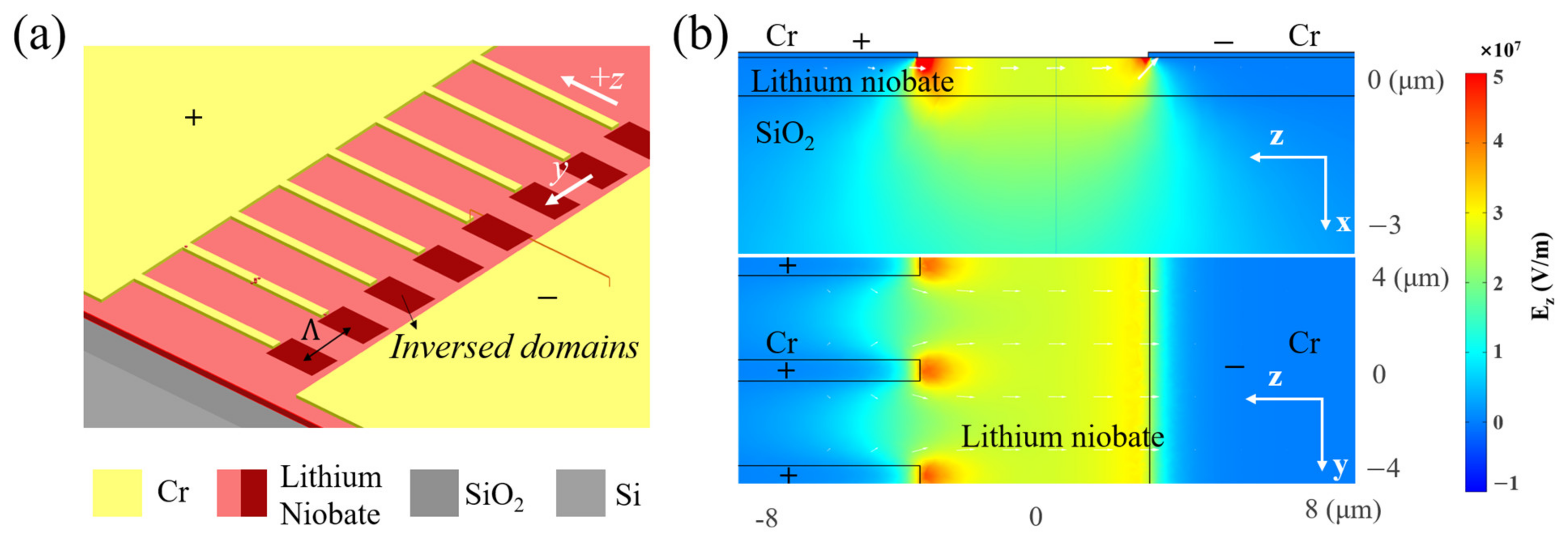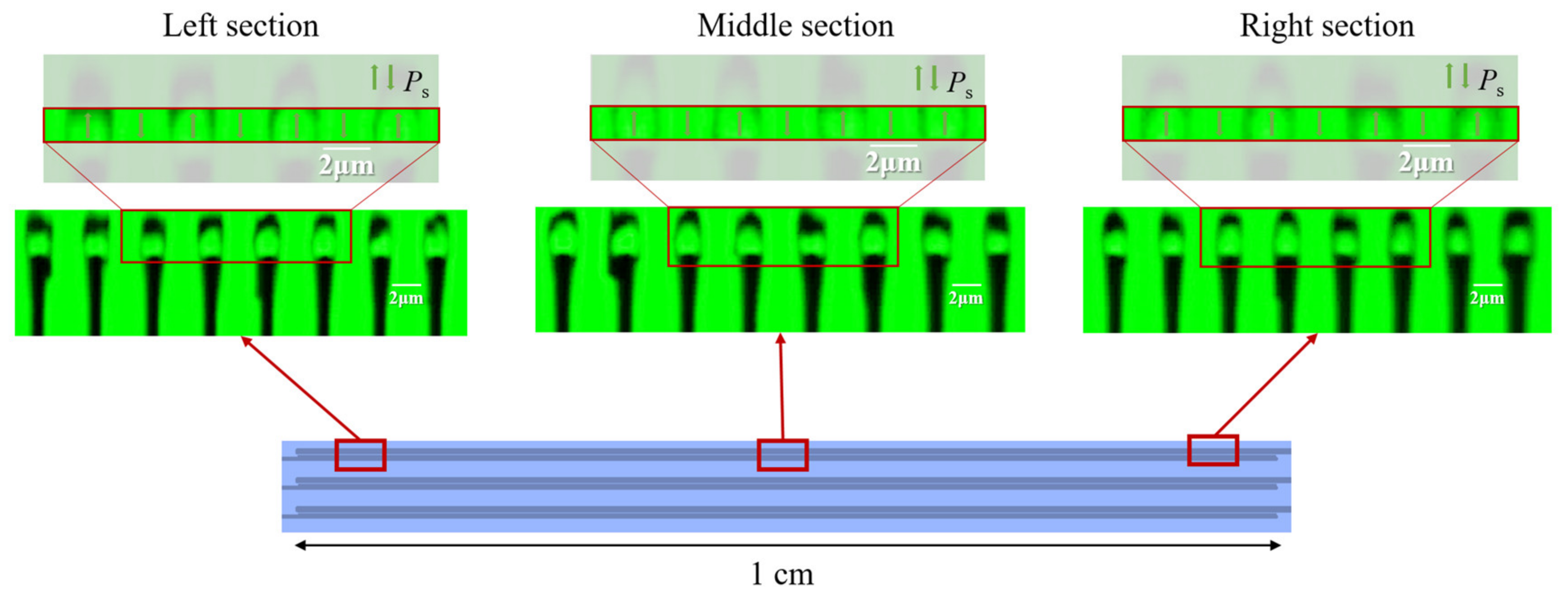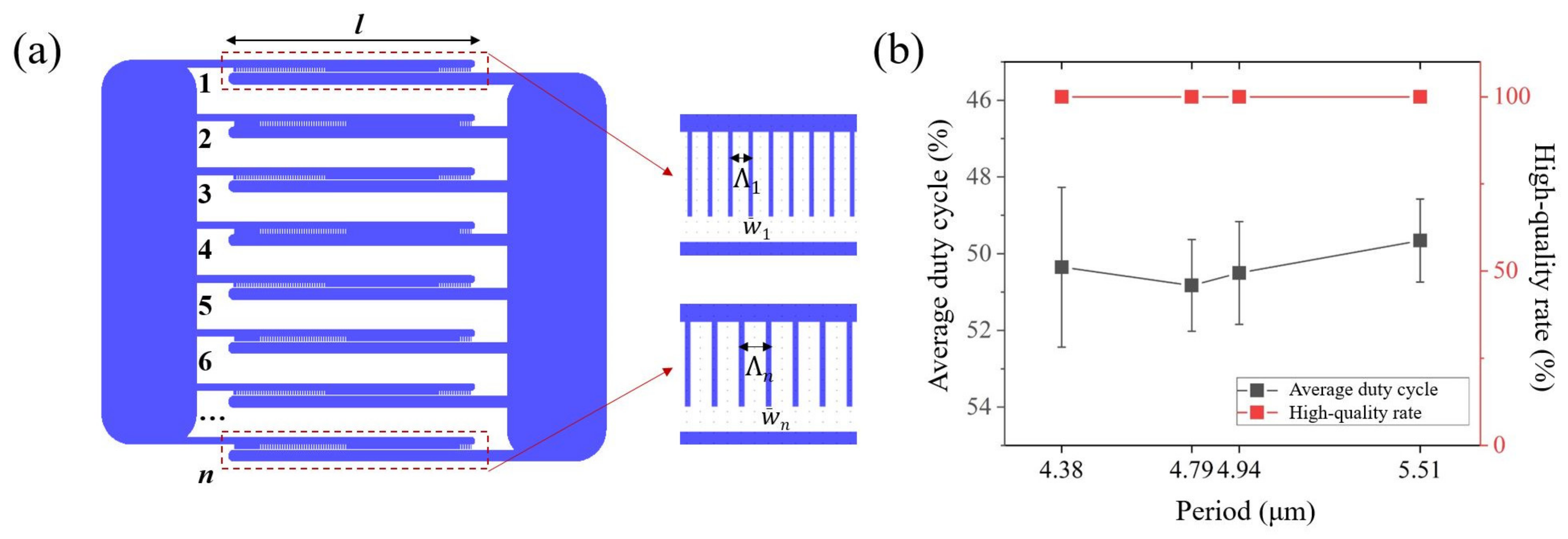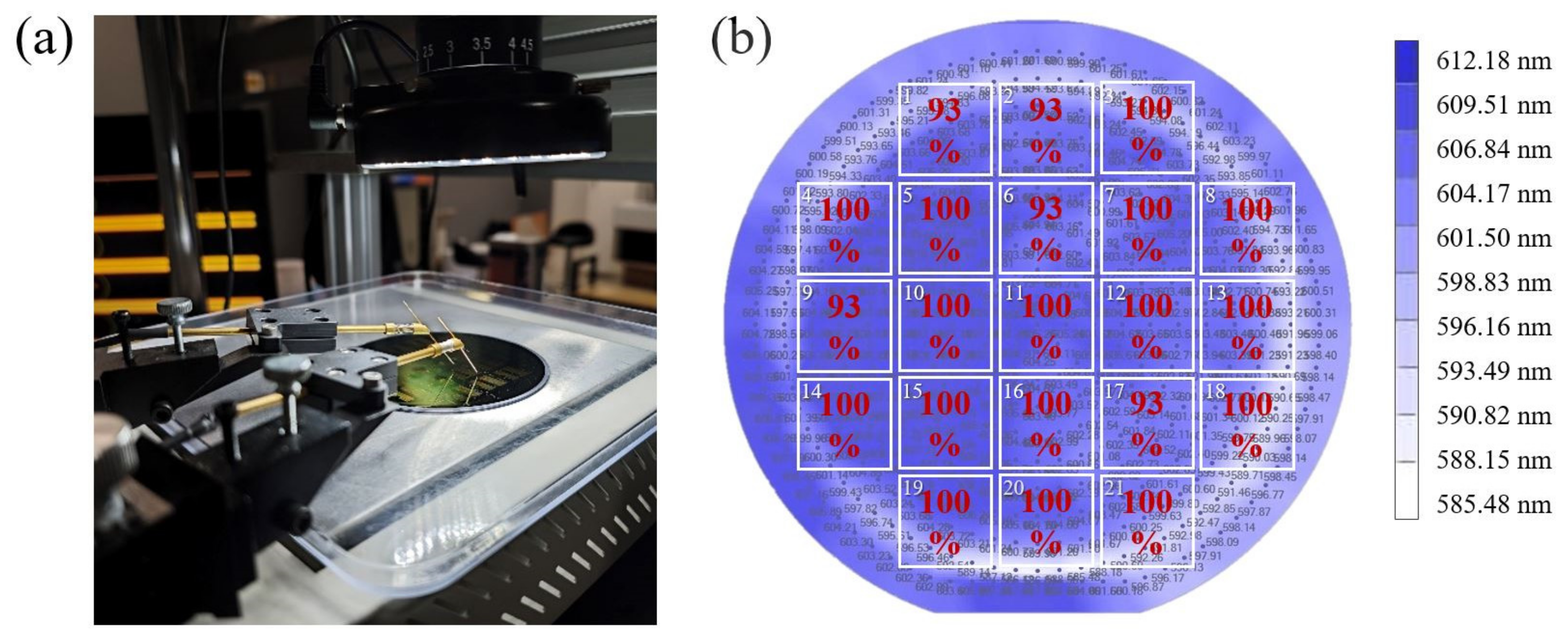Wafer-Scale Periodic Poling of Thin-Film Lithium Niobate
Abstract
1. Introduction
2. Theory
2.1. QPM
2.2. Periodic Poling
3. Design and Experiment
3.1. Design of Electrodes
3.2. Fabrication and Poling
4. Results and Discussion
4.1. Characterization of Inverse Domains: Single Devices
4.2. Domain Inversion: Groups
4.3. Domain Inversion: The Entire Wafer
5. Conclusions
Author Contributions
Funding
Institutional Review Board Statement
Informed Consent Statement
Data Availability Statement
Conflicts of Interest
References
- Boes, A.; Chang, L.; Langrock, C.; Yu, M.; Zhang, M.; Lin, Q.; Lončar, M.; Fejer, M.; Bowers, J.; Mitchell, A. Lithium Niobate Photonics: Unlocking the Electromagnetic Spectrum. Science 2023, 379, eabj4396. [Google Scholar] [CrossRef]
- Zhu, D.; Shao, L.; Yu, M.; Cheng, R.; Desiatov, B.; Xin, C.J.; Hu, Y.; Holzgrafe, J.; Ghosh, S.; Shams-Ansari, A.; et al. Integrated Photonics on Thin-Film Lithium Niobate. Adv. Opt. Photonics 2021, 13, 242. [Google Scholar] [CrossRef]
- Miller, R.C.; Nordland, W.A.; Bridenbaugh, P.M. Dependence of Second-Harmonic-Generation Coefficients of LiNbO3 on Melt Composition. J. Appl. Phys. 1971, 42, 4145–4147. [Google Scholar] [CrossRef]
- Chen, G.; Li, N.; Ng, J.D.; Lin, H.-L.; Zhou, Y.; Fu, Y.H.; Lee, L.Y.T.; Yu, Y.; Liu, A.-Q.; Danner, A.J. Advances in Lithium Niobate Photonics: Development Status and Perspectives. Adv. Photonics 2022, 4, 34003. [Google Scholar] [CrossRef]
- Qi, Y.; Li, Y. Integrated Lithium Niobate Photonics. Nanophotonics 2020, 9, 1287–1320. [Google Scholar] [CrossRef]
- Liu, J.-M.; Zhang, D.-L. Ultra-Broadband on-Chip Mode Size Converter Based on Metasurface and Taper on Lithium-Niobate-on-Insulator Platform. Opt. Mater. 2024, 147, 114779. [Google Scholar] [CrossRef]
- Wu, S.; Song, W.; Sun, J.; Lin, Z.; Xin, H.; Zhu, S.; Li, T. Broadband Asymmetric Light Transport in Compact Lithium Niobate Waveguides. Laser Photonics Rev. 2023, 17, 2300306. [Google Scholar] [CrossRef]
- Chen, P.-K.; Briggs, I.; Cui, C.; Zhang, L.; Shah, M.; Fan, L. Adapted Poling to Break the Nonlinear Efficiency Limit in Nanophotonic Lithium Niobate Waveguides. Nat. Nanotechnol. 2024, 19, 44–50. [Google Scholar] [CrossRef]
- Mishra, J.; McKenna, T.P.; Ng, E.; Stokowski, H.S.; Jankowski, M.; Langrock, C.; Heydari, D.; Mabuchi, H.; Fejer, M.M.; Safavi-Naeini, A.H. Mid-Infrared Nonlinear Optics in Thin-Film Lithium Niobate on Sapphire. Optica 2021, 8, 921. [Google Scholar] [CrossRef]
- Mishra, J.; Jankowski, M.; Hwang, A.Y.; Stokowski, H.S.; McKenna, T.P.; Langrock, C.; Ng, E.; Heydari, D.; Mabuchi, H.; Safavi-Naeini, A.H.; et al. Ultra-Broadband Mid-Infrared Generation in Dispersion-Engineered Thin-Film Lithium Niobate. Opt. Express 2022, 30, 32752. [Google Scholar] [CrossRef]
- Jankowski, M.; Jornod, N.; Langrock, C.; Desiatov, B.; Marandi, A.; Lončar, M.; Fejer, M.M. Quasi-Static Optical Parametric Amplification. Optica 2022, 9, 273. [Google Scholar] [CrossRef]
- Lu, J.; Al Sayem, A.; Gong, Z.; Surya, J.B.; Zou, C.-L.; Tang, H.X. Ultralow-Threshold Thin-Film Lithium Niobate Optical Parametric Oscillator. Optica 2021, 8, 539. [Google Scholar] [CrossRef]
- Ledezma, L.; Roy, A.; Costa, L.; Sekine, R.; Gray, R.; Guo, Q.; Nehra, R.; Briggs, R.M.; Marandi, A. Octave-Spanning Tunable Infrared Parametric Oscillators in Nanophotonics. Sci. Adv. 2023, 9, eadf9711. [Google Scholar] [CrossRef]
- Roy, A.; Ledezma, L.; Costa, L.; Gray, R.; Sekine, R.; Guo, Q.; Liu, M.; Briggs, R.M.; Marandi, A. Visible-to-Mid-IR Tunable Frequency Comb in Nanophotonics. Nat. Commun. 2023, 14, 6549. [Google Scholar] [CrossRef]
- Luke, K.; Kharel, P.; Reimer, C.; He, L.; Loncar, M.; Zhang, M. Wafer-Scale Low-Loss Lithium Niobate Photonic Integrated Circuits. Opt. Express 2020, 28, 24452. [Google Scholar] [CrossRef]
- Lehmann, L.; Grossard, L.; Delage, L.; Reynaud, F.; Chauvet, M.; Bassignot, F. Single Photon MIR Upconversion Detector at Room Temperature with a PPLN Ridge Waveguide. Opt. Express 2019, 27, 19233. [Google Scholar] [CrossRef]
- Snigirev, V.; Riedhauser, A.; Lihachev, G.; Churaev, M.; Riemensberger, J.; Wang, R.N.; Siddharth, A.; Huang, G.; Möhl, C.; Popoff, Y.; et al. Ultrafast Tunable Lasers Using Lithium Niobate Integrated Photonics. Nature 2023, 615, 411–417. [Google Scholar] [CrossRef]
- Safian, R.; Teng, M.; Zhuang, L.; Chakravarty, S. Foundry-Compatible Thin Film Lithium Niobate Modulator with RF Electrodes Buried inside the Silicon Oxide Layer of the SOI Wafer. Opt. Express 2020, 28, 25843. [Google Scholar] [CrossRef]
- Li, Z.; Wang, R.N.; Lihachev, G.; Zhang, J.; Tan, Z.; Churaev, M.; Kuznetsov, N.; Siddharth, A.; Bereyhi, M.J.; Riemensberger, J.; et al. High Density Lithium Niobate Photonic Integrated Circuits. Nat. Commun. 2023, 14, 4856. [Google Scholar] [CrossRef]
- Zhang, H.; Zhu, H.; Li, Q.; Hu, H. Reversed Domains in X-Cut Lithium Niobate Thin Films. Opt. Mater. 2020, 109, 110364. [Google Scholar] [CrossRef]
- Shur, V.Y.; Rumyantsev, E.L. Kinetics of Ferroelectric Domain Structure during Switching: Theory and Experiment. Ferroelectrics 1994, 151, 171–180. [Google Scholar] [CrossRef]
- Lin, J.; Bo, F.; Cheng, Y.; Xu, J. Advances in On-Chip Photonic Devices Based on Lithium Niobate on Insulator. Photonics Res. 2020, 8, 1910. [Google Scholar] [CrossRef]
- Rüsing, M.; Zhao, J.; Mookherjea, S. Second Harmonic Microscopy of Poled X-Cut Thin Film Lithium Niobate: Understanding the Contrast Mechanism. J. Appl. Phys. 2019, 126, 114105. [Google Scholar] [CrossRef]
- Berth, G.; Wiedemeier, V.; Hüsch, K.-P.; Gui, L.; Hu, H.; Sohler, W.; Zrenner, A. Imaging of Ferroelectric Micro-Domains in X-Cut Lithium Niobate by Confocal Second Harmonic Microscopy. Ferroelectrics 2009, 389, 132–141. [Google Scholar] [CrossRef]
- Yamada, M.; Nada, N.; Saitoh, M.; Watanabe, K. First-Order Quasi-Phase Matched LiNbO3 Waveguide Periodically Poled by Applying an External Field for Efficient Blue Second-Harmonic Generation. Appl. Phys. Lett. 1993, 62, 435–436. [Google Scholar] [CrossRef]
- Burns, W.K.; McElhanon, W.; Goldberg, L. Second Harmonic Generation in Field Poled, Quasi-Phase-Matched, Bulk LiNbO/Sub 3/. IEEE Photonics Technol. Lett. 1994, 6, 252–254. [Google Scholar] [CrossRef]
- Myers, L.E.; Miller, G.D.; Eckardt, R.C.; Fejer, M.M.; Byer, R.L.; Bosenberg, W.R. Quasi-Phase-Matched 1.064-mm-Pumped Optical Parametric Oscillator in Bulk Periodically Poled LiNbO3. Opt. Lett. 1995, 20, 52–54. [Google Scholar] [CrossRef]
- Zhu, S.; Zhu, Y.; Zhang, Z.; Shu, H.; Wang, H.; Hong, J.; Ge, C.; Ming, N. LiTaO3 Crystal Periodically Poled by Applying an External Pulsed Field. J. Appl. Phys. 1995, 77, 5481–5483. [Google Scholar] [CrossRef]
- Xie, Z.; Zhu, S. LiNbO3 Crystals: From Bulk to Film. Adv. Photonics 2022, 4, 030502. [Google Scholar] [CrossRef]
- Boes, A.; Corcoran, B.; Chang, L.; Bowers, J.; Mitchell, A. Status and Potential of Lithium Niobate on Insulator (LNOI) for Photonic Integrated Circuits. Laser Photonics Rev. 2018, 12, 1700256. [Google Scholar] [CrossRef]
- Lu, J.; Surya, J.B.; Liu, X.; Bruch, A.W.; Gong, Z.; Xu, Y.; Tang, H.X. Periodically Poled Thin-Film Lithium Niobate Microring Resonators with a Second-Harmonic Generation Efficiency of 250,000%/W. Optica 2019, 6, 1455. [Google Scholar] [CrossRef]
- Niu, Y.; Lin, C.; Liu, X.; Chen, Y.; Hu, X.; Zhang, Y.; Cai, X.; Gong, Y.-X.; Xie, Z.; Zhu, S. Optimizing the Efficiency of a Periodically Poled LNOI Waveguide Using in Situ Monitoring of the Ferroelectric Domains. Appl. Phys. Lett. 2020, 116, 101104. [Google Scholar] [CrossRef]
- Wang, C.; Langrock, C.; Marandi, A.; Jankowski, M.; Zhang, M.; Desiatov, B.; Fejer, M.M.; Lončar, M. Ultrahigh-Efficiency Wavelength Conversion in Nanophotonic Periodically Poled Lithium Niobate Waveguides. Optica 2018, 5, 1438. [Google Scholar] [CrossRef]
- Wang, X.; Jiao, X.; Wang, B.; Liu, Y.; Xie, X.-P.; Zheng, M.-Y.; Zhang, Q.; Pan, J.-W. Quantum Frequency Conversion and Single-Photon Detection with Lithium Niobate Nanophotonic Chips. npj Quantum Inf. 2023, 9, 38. [Google Scholar] [CrossRef]
- McKenna, T.P.; Stokowski, H.S.; Ansari, V.; Mishra, J.; Jankowski, M.; Sarabalis, C.J.; Herrmann, J.F.; Langrock, C.; Fejer, M.M.; Safavi-Naeini, A.H. Ultra-Low-Power Second-Order Nonlinear Optics on a Chip. Nat. Commun. 2022, 13, 4532. [Google Scholar] [CrossRef]
- Shur, V.Y.; Rumyantsev, E.L.; Batchko, R.G.; Miller, G.D.; Fejer, M.M.; Byer, R.L. Domain Kinetics in the Formation of a Periodic Domain Structure in Lithium Niobate. Phys. Solid State 1999, 41, 1681–1687. [Google Scholar] [CrossRef]
- Xu, X.; Wang, T.; Chen, P.; Zhou, C.; Ma, J.; Wei, D.; Wang, H.; Niu, B.; Fang, X.; Wu, D.; et al. Femtosecond Laser Writing of Lithium Niobate Ferroelectric Nanodomains. Nature 2022, 609, 496–501. [Google Scholar] [CrossRef]
- Jiao, Y.; Shao, Z.; Li, S.; Wang, X.; Bo, F.; Xu, J.; Zhang, G. Nano-Domains Produced through a Two-Step Poling Technique in Lithium Niobate on Insulators. Materials 2020, 13, 3617. [Google Scholar] [CrossRef]
- Jankowski, M.; Langrock, C.; Desiatov, B.; Marandi, A.; Wang, C.; Zhang, M.; Phillips, C.R.; Lončar, M.; Fejer, M.M. Ultrabroadband Nonlinear Optics in Nanophotonic Periodically Poled Lithium Niobate Waveguides. Optica 2020, 7, 40. [Google Scholar] [CrossRef]
- Nagy, J.T.; Reano, R.M. Reducing Leakage Current during Periodic Poling of Ion-Sliced x-Cut MgO Doped Lithium Niobate Thin Films. Opt. Mater. Express 2019, 9, 3146. [Google Scholar] [CrossRef]
- Armstrong, J.A.; Bloembergen, N.; Ducuing, J.; Pershan, P.S. Interactions between Light Waves in a Nonlinear Dielectric. Phys. Rev. 1962, 127, 1918–1939. [Google Scholar] [CrossRef]
- Feng, D.; Ming, N.-B.; Hong, J.-F.; Yang, Y.-S.; Zhu, J.-S.; Yang, Z.; Wang, Y.-N. Enhancement of Second-Harmonic Generation in LiNbO3 Crystals with Periodic Laminar Ferroelectric Domains. Appl. Phys. Lett. 1980, 37, 607–609. [Google Scholar] [CrossRef]
- Ming, N.-B.; Hong, J.-F.; Feng, D. The Growth Striations and Ferroelectric Domain Structures in Czochralski-Grown LiNbO3 Single Crystals. J. Mater. Sci. 1982, 17, 1663–1670. [Google Scholar] [CrossRef]
- Lu, Y.; Wei, T.; Duewer, F.; Lu, Y.; Ming, N.-B.; Schultz, P.G.; Xiang, X.-D. Nondestructive Imaging of Dielectric-Constant Profiles and Ferroelectric Domains with a Scanning-Tip Microwave Near-Field Microscope. Science 1997, 276, 2004–2006. [Google Scholar] [CrossRef]
- Rambu, A.P.; Tiron, V.; Oniciuc, E.; Tascu, S. Spontaneous Polarization Reversal Induced by Proton Exchange in Z-Cut Lithium Niobate α-Phase Channel Waveguides. Materials 2021, 14, 7127. [Google Scholar] [CrossRef] [PubMed]
- Parameswaran, K.R.; Route, R.K.; Kurz, J.R.; Roussev, R.V.; Fejer, M.M.; Fujimura, M. Highly Efficient Second-Harmonic Generation in Buried Waveguides Formed by Annealed and Reverse Proton Exchange in Periodically Poled Lithium Niobate. Opt. Lett. 2002, 27, 179. [Google Scholar] [CrossRef] [PubMed]
- Jin, H.; Liu, F.M.; Xu, P.; Xia, J.L.; Zhong, M.L.; Yuan, Y.; Zhou, J.W.; Gong, Y.X.; Wang, W.; Zhu, S.N. On-Chip Generation and Manipulation of Entangled Photons Based on Reconfigurable Lithium-Niobate Waveguide Circuits. Phys. Rev. Lett. 2014, 113, 103601. [Google Scholar] [CrossRef]
- Xue, G.-T.; Niu, Y.-F.; Liu, X.; Duan, J.-C.; Chen, W.; Pan, Y.; Jia, K.; Wang, X.; Liu, H.-Y.; Zhang, Y.; et al. Ultrabright Multiplexed Energy-Time-Entangled Photon Generation from Lithium Niobate on Insulator Chip. Phys. Rev. Appl. 2021, 15, 064059. [Google Scholar] [CrossRef]
- Nakamura, K.; Kurz, J.; Parameswaran, K.; Fejer, M.M. Periodic Poling of Magnesium-Oxide-Doped Lithium Niobate. J. Appl. Phys. 2002, 91, 4528–4534. [Google Scholar] [CrossRef]
- Poberaj, G.; Hu, H.; Sohler, W.; Günter, P. Lithium Niobate on Insulator (LNOI) for Micro-photonic Devices. Laser Photonics Rev. 2012, 6, 488–503. [Google Scholar] [CrossRef]
- Chang, L.; Li, Y.; Volet, N.; Wang, L.; Peters, J.; Bowers, J.E. Thin Film Wavelength Converters for Photonic Integrated Circuits. Optica 2016, 3, 531. [Google Scholar] [CrossRef]
- Hum, D.S.; Fejer, M.M. Quasi-Phasematching. Comptes Rendus Phys. 2007, 8, 180–198. [Google Scholar] [CrossRef]






Disclaimer/Publisher’s Note: The statements, opinions and data contained in all publications are solely those of the individual author(s) and contributor(s) and not of MDPI and/or the editor(s). MDPI and/or the editor(s) disclaim responsibility for any injury to people or property resulting from any ideas, methods, instructions or products referred to in the content. |
© 2024 by the authors. Licensee MDPI, Basel, Switzerland. This article is an open access article distributed under the terms and conditions of the Creative Commons Attribution (CC BY) license (https://creativecommons.org/licenses/by/4.0/).
Share and Cite
Chen, M.; Wang, C.; Tian, X.-H.; Tang, J.; Gu, X.; Qian, G.; Jia, K.; Liu, H.-Y.; Yan, Z.; Ye, Z.; et al. Wafer-Scale Periodic Poling of Thin-Film Lithium Niobate. Materials 2024, 17, 1720. https://doi.org/10.3390/ma17081720
Chen M, Wang C, Tian X-H, Tang J, Gu X, Qian G, Jia K, Liu H-Y, Yan Z, Ye Z, et al. Wafer-Scale Periodic Poling of Thin-Film Lithium Niobate. Materials. 2024; 17(8):1720. https://doi.org/10.3390/ma17081720
Chicago/Turabian StyleChen, Mengwen, Chenyu Wang, Xiao-Hui Tian, Jie Tang, Xiaowen Gu, Guang Qian, Kunpeng Jia, Hua-Ying Liu, Zhong Yan, Zhilin Ye, and et al. 2024. "Wafer-Scale Periodic Poling of Thin-Film Lithium Niobate" Materials 17, no. 8: 1720. https://doi.org/10.3390/ma17081720
APA StyleChen, M., Wang, C., Tian, X.-H., Tang, J., Gu, X., Qian, G., Jia, K., Liu, H.-Y., Yan, Z., Ye, Z., Yin, Z., Zhu, S.-N., & Xie, Z. (2024). Wafer-Scale Periodic Poling of Thin-Film Lithium Niobate. Materials, 17(8), 1720. https://doi.org/10.3390/ma17081720






